
A passerine is any bird of the order Passeriformes, which includes more than half of all bird species. Sometimes known as perching birds or songbirds, passerines are distinguished from other orders of birds by the arrangement of their toes, which facilitates perching.

The trogons and quetzals are birds in the order Trogoniformes which contains only one family, the Trogonidae. The family Trogonidae contains 46 species in seven genera. The fossil record of the trogons dates back 49 million years to the Early Eocene. They might constitute a member of the basal radiation of the order Coraciiformes and order Passeriformes or be closely related to mousebirds and owls. The word trogon is Greek for "nibbling" and refers to the fact that these birds gnaw holes in trees to make their nests.
Near passerines and higher land-bird assemblage are terms of traditional, pre-cladistic taxonomy that have often been given to tree-dwelling birds or those most often believed to be related to the true passerines owing to morphological and ecological similarities; the group corresponds to some extent with the Anomalogonatae of Alfred Henry Garrod.
The Sibley–Ahlquist taxonomy is a bird taxonomy proposed by Charles Sibley and Jon E. Ahlquist. It is based on DNA–DNA hybridization studies conducted in the late 1970s and throughout the 1980s.

The Coraciiformes are a group of usually colourful birds including the kingfishers, the bee-eaters, the rollers, the motmots, and the todies. They generally have syndactyly, with three forward-pointing toes, though in many kingfishers one of these is missing.

Woodpeckers are part of the family Picidae, which also includes the piculets, wrynecks, and sapsuckers. Members of this family are found worldwide, except for Australia, New Guinea, New Zealand, Madagascar, and the extreme polar regions. Most species live in forests or woodland habitats, although a few species are known that live in treeless areas, such as rocky hillsides and deserts, and the Gila woodpecker specialises in exploiting cacti.
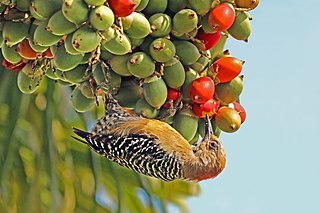
Nine families of largely arboreal birds make up the order Piciformes, the best-known of them being the Picidae, which includes the woodpeckers and close relatives. The Piciformes contain about 71 living genera with a little over 450 species, of which the Picidae make up about half.
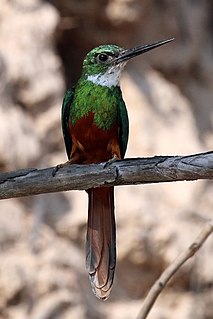
The jacamars are a family, Galbulidae, of near passerine birds from tropical South and Central America, extending up to Mexico. The family contains five genera and 18 species. The family is closely related to the puffbirds, another Neotropical family, and the two families are often separated into their own order, Galbuliformes, separate from the Piciformes. They are principally birds of low-altitude woodlands and forests, and particularly of forest edge and canopy.

The puffbirds and their relatives in the near passerine family Bucconidae are tropical tree-dwelling insectivorous birds that are found from South America up to Mexico. Together with their closest relatives, the jacamars, they form a divergent lineage within the order Piciformes, though the two families are sometimes elevated to a separate order Galbuliformes. Lacking the iridescent colours of the jacamars, puffbirds are mainly brown, rufous or grey, with large heads, large eyes, and flattened bills with a hooked tip. Their loose, abundant plumage and short tails makes them look stout and puffy, giving rise to the English name of the family. The species range in size from the rufous-capped nunlet, at 13 cm (5.1 in) and 14 g (0.49 oz), to the white-necked puffbird, at up to 29 cm (11 in) and 106 g (3.7 oz).
Neanis is an extinct genus of bird probably related to woodpeckers and toucans. It contains at least one species, N. schucherti; N. kistneri resembles this, but it probably belongs to a distinct genus and may not be closely related. Both are known from the Late Wasatchian stratum of the Early Eocene Green River Formation of the Western-Central USA. "N." kistneri is known from one fairly complete, but not very well preserved skeleton, whereas of N. schucherti even less material was found.

Bucerotiformes is an order of birds that contains the hornbills, ground hornbills, hoopoes and wood hoopoes. These birds were previously classified as members of Coraciiformes. The clade is distributed in Africa, Asia, Europe and Melanesia.

Green toucanets are near-passerine birds from the genus Aulacorhynchus in the toucan family. They are native to Mexico, and Central and South America. All are found in humid forests and woodlands in highlands, but a few also occur in adjacent lowlands. They are relatively small toucans, 30–44 centimetres (12–17 in) long, with colorful, mainly green, plumage. They are typically seen in pairs or small groups, and sometimes follow mixed species flocks.

Galbula is the type and largest genus of the jacamar family (Galbulidae) of piciform birds, and its suborder Galbulae. Sometimes, the Piciformes are split in two, with the Galbulae upranked to full order Galbuliformes.
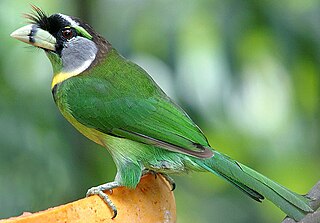
Psilopogon is a genus of Old World barbets that used to include only a single species, the fire-tufted barbet. Results of molecular phylogenetic analyses indicate that the genus is nested within an evolutionary branch consisting of Asian barbets that were formerly placed in the genus Megalaima proposed by George Robert Gray in 1841. Since Psilopogon was proposed by Salomon Müller already in 1835, this name takes priority.
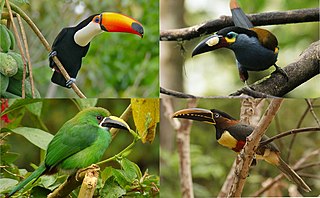
Toucans are members of the Neotropical near passerine bird family Ramphastidae. The Ramphastidae are most closely related to the American barbets. They are brightly marked and have large, often colorful bills. The family includes five genera and over forty different species.
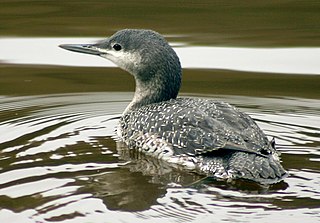
Ardeae is a clade of birds that contains Eurypygimorphae and Aequornithes, named in 2014 by genome analysis. Members of Eurypygimorphae were originally classified in the obsolete group Metaves, and Aequornithes were classified as the sister taxon to Musophagiformes or Gruiformes.

Picocoraciae is a clade that contains the order Bucerotiformes and the clade Picodynastornithes supported by various genetic analysis and morphological studies. While these studies supported a sister grouping of Coraciiformes and Piciformes, a large scale, sparse supermatrix has suggested alternative sister relationship between Bucerotiformes and Piciformes instead.

Ramphastides is an infraorder of the order Piciformes that includes toucans and barbets. Formerly, the barbets have been classified in a single family, the Capitonidae. However, this has turned out to be paraphyletic with regard to toucans, which resulted in the Capitonidae being split into several families.

Galbuli is one of the two suborders of the order Piciformes and includes two families Bucconidae (puffbirds) and Galbulidae (jacamars). The other suborder Pici is a global group of piciforms, puffbirds and jacamars are only found in the Neotropics.

Picodynastornithes is a clade that contains the orders Coraciiformes and Piciformes. This grouping also has current and historical support from molecular and morphological studies.
















